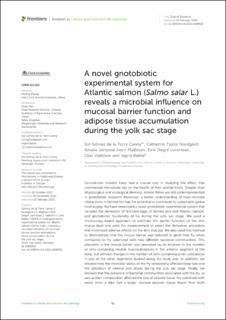| dc.contributor.author | Gomez de la Torre Canny, Sol | |
| dc.contributor.author | Nordgård, Catherine Taylor | |
| dc.contributor.author | Mathisen, Amalie johanne Horn | |
| dc.contributor.author | Degré Lorentsen, Eirik | |
| dc.contributor.author | Vadstein, Olav | |
| dc.contributor.author | Bakke, Ingrid | |
| dc.date.accessioned | 2023-11-08T06:58:57Z | |
| dc.date.available | 2023-11-08T06:58:57Z | |
| dc.date.created | 2023-06-15T23:08:09Z | |
| dc.date.issued | 2023 | |
| dc.identifier.issn | 2235-2988 | |
| dc.identifier.uri | https://hdl.handle.net/11250/3101239 | |
| dc.description.abstract | Gnotobiotic models have had a crucial role in studying the effect that commensal microbiota has on the health of their animal hosts. Despite their physiological and ecological diversity, teleost fishes are still underrepresented in gnotobiotic research. Moreover, a better understanding of host-microbe interactions in farmed fish has the potential to contribute to sustainable global food supply. We have developed a novel gnotobiotic experimental system that includes the derivation of fertilized eggs of farmed and wild Atlantic salmon, and gnotobiotic husbandry of fry during the yolk sac stage. We used a microscopy-based approach to estimate the barrier function of the skin mucus layer and used this measurement to select the derivation procedure that minimized adverse effects on the skin mucosa. We also used this method to demonstrate that the mucus barrier was reduced in germ-free fry when compared to fry colonized with two different bacterial communities. This alteration in the mucus barrier was preceded by an increase in the number of cells containing neutral mucosubstances in the anterior segment of the body, but without changes in the number of cells containing acidic substances in any of the other segments studied along the body axis. In addition, we showed how the microbial status of the fry temporarily affected body size and the utilization of internal yolk stores during the yolk sac stage. Finally, we showed that the presence of bacterial communities associated with the fry, as well as their composition, affected the size of adipose tissue. Fry colonized with water from a lake had a larger visceral adipose tissue depot than both conventionally raised and germ-free fry. Together, our results show that this novel gnotobiotic experimental system is a useful tool for the study of host-microbe interactions in this species of aquacultural importance. | en_US |
| dc.language.iso | eng | en_US |
| dc.publisher | Frontiers Media S. A. | en_US |
| dc.rights | Navngivelse 4.0 Internasjonal | * |
| dc.rights.uri | http://creativecommons.org/licenses/by/4.0/deed.no | * |
| dc.title | A novel gnotobiotic experimental system for Atlantic salmon ( Salmo salar L.) reveals a microbial influence on mucosal barrier function and adipose tissue accumulation during the yolk sac stage | en_US |
| dc.title.alternative | A novel gnotobiotic experimental system for Atlantic salmon ( Salmo salar L.) reveals a microbial influence on mucosal barrier function and adipose tissue accumulation during the yolk sac stage | en_US |
| dc.type | Peer reviewed | en_US |
| dc.type | Journal article | en_US |
| dc.description.version | publishedVersion | en_US |
| dc.source.volume | 12 | en_US |
| dc.source.journal | Frontiers in Cellular and Infection Microbiology | en_US |
| dc.identifier.doi | 10.3389/fcimb.2022.1068302 | |
| dc.identifier.cristin | 2155102 | |
| cristin.ispublished | true | |
| cristin.fulltext | original | |
| cristin.qualitycode | 1 | |

